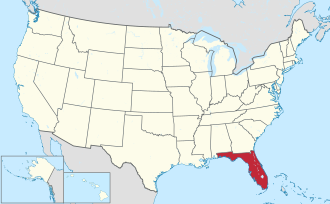Martin County, Florida | |
|---|---|
 Martin County Courthouse | |
 Location within the U.S. state of Florida | |
 Florida's location within the U.S. | |
| Coordinates: 27°05′N80°24′W / 27.08°N 80.4°W | |
| Country | |
| State | |
| Founded | May 30, 1925 |
| Named after | John W. Martin |
| Seat | Stuart |
| Largest community | Palm City |
| Area | |
• Total | 753 sq mi (1,950 km2) |
| • Land | 543 sq mi (1,410 km2) |
| • Water | 209 sq mi (540 km2) 27.8% |
| Population (2020) | |
• Total | 158,431 [1] |
• Estimate (2023) | 163,315 |
| • Density | 292/sq mi (113/km2) |
| Time zone | UTC−5 (Eastern) |
| • Summer (DST) | UTC−4 (EDT) |
| Congressional district | 21st |
| Website | www |

Martin County is a county located in the southeastern part of the state of Florida, in the United States. As of the 2020 census, the population was 158,431. [2] Its county seat is Stuart. [3] Martin County is in the Port St. Lucie, FL Metropolitan Statistical Area.
Contents
- History
- Geography
- Adjacent counties
- National protected area
- Environment
- Martin County Shore Protection Project
- Demographics
- 2020 census
- 2000 census
- Transportation
- Airports
- Major highways
- Buses
- Intercity rail
- Trails
- Government
- Board of County Commissioners
- Constitutional officers
- School district
- Electoral politics
- Voter registration
- Libraries
- Attractions
- Historic areas
- Communities
- City
- Towns
- Villages
- Census-designated places
- Other unincorporated places
- Gallery
- See also
- References
- External links











